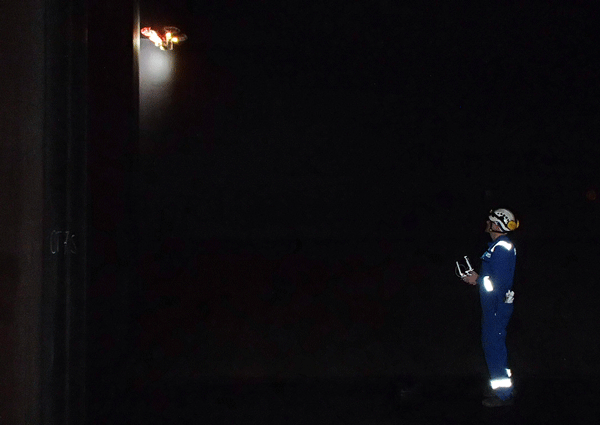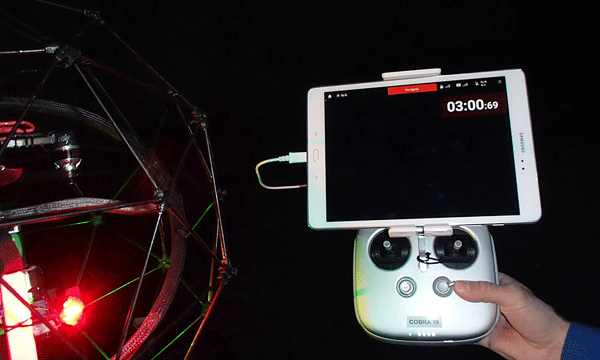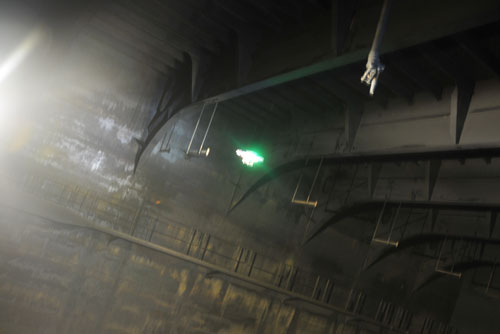The first production survey using an unmanned aerial vehicle (UAV) to assist surveyors was recently completed by classification society DNV GL (Høvik, Norway). The survey, which took place on the MV Apollo, a chemical tanker owned by Carl Büttner Shipmanagement GmbH in Bremerhaven, Germany, was completed in two and a half days by two DNV GL surveyors who used a UAV, also known as a drone, to help assess 14 cargo tanks.
Inspecting ship tanks and holds can be a costly, time consuming, and potentially dangerous operation. Assessing structures such as piping, access points, equipment, and safety systems for coating condition, corrosion, and damage needs to be done on a regular basis. The sheer size of today’s vessels, however, requires staging, rafting, and climbing for surveyors to access areas slated for inspection and make their observations. By using UAV technology, surveyor safety is improved and survey times and staging costs associated with visual condition checks of remote structural components can be significantly reduced. For the MV Apollo survey, eliminating the staging construction realized a time savings of two to three days for all 14 tanks, with total costs savings estimated to be somewhere between €14,000 to €28,000, or €1,000 to €2,000 per scaffold per tank. With a UAV, a complete close-up survey of a cargo tank measuring ~20 by 30 by 15 m takes about two to three hours.

To ensure that the required safety and quality levels are reached, DNV GL is in the process of developing an in-house guideline to cover drone-assisted surveys performed by its surveyors.
To visually evaluate the MV Apollo’s structural components, the two surveyors used a UAV equipped with a DJI Phantom 3 camera that streamed live video to a tablet. One surveyor piloted the UAV, while the other focused on the real-time video feed. Additional lights were installed on the UAV, and its propellers were fitted with protective gear. Because the additional lights reduced the UAV’s battery life, the survey team had six to seven charged batteries available and landed the UAV approximately every 15 min to furnish it with a fresh battery.
The images generated by the UAV captured a level of detail equivalent to that of the human eye from a distance of 1.5 m, as specified in DNV-GL/IACS requirements. This means the results can be used in official surveys, DNV GL says. The video stream was also recorded for review and documentation purposes.
“The advantage of using a drone over conventional staging inside the tank is absolutely clear,” says Jochen Huhn, marine superintendent and chief security officer with Carl Büttner Shipmanagement GmbH. “Eliminating the risk of damage to the coating from staging means the drone survey is worth it, even before we factor in the time saved by this method. We were also all very impressed by the quality of the video and the details the drone was able to obtain in the inspection. We would certainly be interested in using this method more in the future and I am interested to see how the technology develops over the next few years.”

DNV GL has tested the use of UAVs to conduct surveys inside ship tanks and completed several tests utilizing UAVs to inspect cargo tanks and holds in a large oil tanker, a chemical tanker, and a bulk carrier, in both Europe and China. In December 2015, several tests using UAVs to support the hull survey of two vessels at the Remontowa shipyard in Gdansk, Poland were completed by a DNV GL classification team.
“We have been looking at ways we could help our customers by accelerating the survey process,” says Cezary Galinski, manager of the DNV GL–Maritime classification flying squad based in Gdansk. “Camera-equipped drones are now much more widely available and affordable, and by using them for a first screening we can identify areas that require closer inspection quickly and without extensive staging, which can be both costly and time-consuming.”
In the event that any damage is detected, a traditional close-up survey of the damaged area may still be required.
Galinski noted that the team used a modified, off-the-shelf UAV for its tests. Because there are no commercially available UAVs currently certified as explosion-proof, the surveyors performed a risk assessment before the inspection and also ensured the cargo tank was gas-free and certified for safe entry before the drone operation started.
The next step, Galinski says, is to develop a more advanced, tailor-made UAV, and the group is working with a supplier to build a custom vehicle for future use. One issue to be addressed is size—a UAV design is needed that can fit through a ship’s standard-size manhole, which can be as small as 400 by 600 mm, and be easily packed by a single surveyor for transport and deployment. Additional design improvements desired by the group include increased battery endurance, a better camera, higher-quality lighting, and enhanced flight stability through the use of ultrasonic and laser-based devices.
Going forward, it may be possible to conduct inspections using fully autonomous UAVs. DNV GL has three-dimensional (3D) models of many of its ships, so a 3D model could be loaded into a UAV’s memory, Galinski explains. The UAV could then orientate itself inside the tank and follow a predefined route, and stop inside the compartment to take a photo or video at points of interest. While the autopilot would handle the UAV’s flight path, the operator could manipulate the camera and lights to assess the structures and document findings.
Using a UAV with an advanced inspection technology such as DNV GL’s IRIS system—a camera and tracking system for inspectors or surveyors working inside tanks that can automatically associate onboard photos taken by the surveyor with the corresponding points inside a 3D model of the vessel’s structure—could be the first step toward an automated survey process. This would include using a UAV to conduct the initial survey, and then running the generated images through an algorithm to determine the hull condition.
At some stage it may be feasible to have a UAV with its own scanning capabilities. The vehicle could be launched into a space, make a scan, create a 3D map, and then carry out an independent survey of the space. “But we are still a fair way away from this,” Galinski says.

Currently, the challenge with autonomous flight in a cargo tank is guidance. UAVs are equipped with magnetic compasses and gyroscopes so they can be guided by a global positioning system (GPS); however, GPS does not work inside a cargo tank. This creates a challenge for a UAV to maintain a stable position inside a tank without any operator input. “We have been testing other solutions such as barometric sensors, but they did not work as well as we hoped because the drone creates a draught as it approaches the deckhead, which means the pressure isn’t stable and the drone thinks it is lower than it actually is,” says Galinski. DNV GL is currently working on this issue, but it is still a little further down the development pipeline.
In the meantime, a special guideline for performing drone-based surveys is being developed, which could lead to remote or autonomous inspections being carried out as part of a survey plan.
DNV GL is also looking into utilizing UAVs and other devices to inspect topside and external structures, as well as internal tanks, on mobile offshore units (MOUs)—buoyant structures engaged in offshore operations, such as drilling, production, storage, and support functions, that can be relocated without major dismantling or modification. Another ongoing project is to establish a certification service that qualifies external UAV operators to perform inspection work on classed MOUs.
“Over the next few years we will continue to work on expanding the ways the drones can be used and the number of stations where we can offer this service. This is a very promising beginning and one that is already showing a significant benefit in terms of time and costs saved.” says Knut Ørbeck-Nilssen, CEO of DNV GL–Maritime.
Source: DNV GL–Maritime, dnvgl.com. Contact Simon Adams, DNV GL–Maritime—E-mail: simon.adams@dnvgl.com.